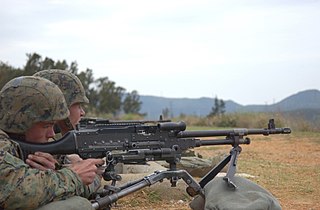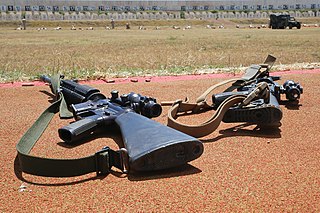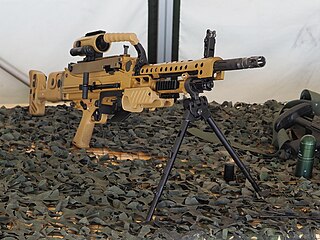
A firearm is any type of gun that uses an explosive charge and is designed to be readily carried and used by an individual. The term is legally defined further in different countries.

A long gun is a category of firearms with long barrels. In small arms, a long gun or longarm is generally designed to be held by both hands and braced against the shoulder, in contrast to a handgun, which can be fired being held with a single hand. In the context of cannons and mounted firearms, an artillery long gun would be contrasted with a field gun or howitzer.

A machine pistol is a handgun that is capable of fully automatic fire, including stockless handgun-style submachine guns.

The IMI Galil is a family of Israeli-made automatic rifles chambered for the 5.56×45mm NATO and 7.62×51mm NATO cartridges. Originally designed by Yisrael Galili and Yakov Lior in the late 1960s, the Galil was first produced by the state-owned Israel Military Industries and is now exported by the privatized Israel Weapon Industries.

A grenade launcher is a weapon that fires a specially designed, large-caliber projectile, often with an explosive, smoke, or gas warhead. Today, the term generally refers to a class of dedicated firearms firing unitary grenade cartridges. The most common type are man-portable, shoulder-fired weapons issued to individuals, although larger crew-served launchers are issued at higher levels of organization by military forces.

The IWINegev is a 5.56×45mm NATO light machine gun developed by Israel Weapon Industries (IWI), formerly Israel Military Industries Ltd. (IMI).

A sawed-off shotgun is a type of shotgun with a shorter gun barrel—typically under 18 inches (46 cm)—and often a pistol grip instead of a longer shoulder stock. Despite the colloquial term, barrels do not, strictly speaking, have to be shortened with a saw. Barrels can be manufactured at shorter lengths as an alternative to traditional, longer barrels. This makes them easier to transport and conceal due to their smaller profile and lighter weight. The design also makes the weapon more portable when maneuvering in confined spaces and for that reason law enforcement and military personnel find it useful in close-quarters combat scenarios. As a result of the shorter barrel length, any shotgun with a tubular magazine will have a reduction in its magazine capacity.

The M240 machine gun, officially the Machine Gun, 7.62 mm, M240, is the U.S. military designation for the FN MAG, a family of belt-fed, gas-operated medium machine guns that chamber the 7.62×51mm NATO cartridge.

The PK is a belt-fed general-purpose machine gun, chambered for the 7.62×54mmR rimmed cartridge.

The lock of a firearm is the mechanism used to initiate firing. It is generally used as a historical term, referring to such mechanisms used in muzzle-loading and early breech-loading firearms, as modern firearms uniformly fire by use of a firing pin to strike the rear of a cartridge. Side-lock refers to the type of construction, in which the individual components of the mechanism are mounted either side of a single plate. The assembly is then mounted to the stock on the side of the firearm. In modern firearm designs, the mechanism to initiate firing is generally constructed within the frame or receiver of the firearm and is referred to as the firing or trigger mechanism.
A gunstock or often simply stock, the back portion of which is also known as a shoulder stock, a buttstock, or simply a butt, is a part of a long gun that provides structural support, to which the barrel, action, and firing mechanism are attached. The stock also provides a means for the shooter to firmly brace the gun and easily aim with stability by being held against the user's shoulder when shooting the gun, and helps to counter muzzle rise by transmitting recoil straight into the shooter's body.

The XM214 Microgun is an American prototype 5.56 mm rotary-barreled machine gun. It was designed and built by General Electric. The XM214 was a scaled-down smaller and lighter version of the M134 Minigun, firing M193 5.56×45mm ammunition.

A medium machine gun (MMG), in modern terms, usually refers to a belt-fed machine gun firing a full-powered rifle cartridge, and is considered "medium" in weight. Medium machine guns are light enough to be infantry-portable, but still cumbersome enough to require a crew for optimal operational efficiency.

The High Standard Model 10 (HS10) is a gas operated, semi-automatic shotgun that was manufactured by the High Standard Manufacturing Company of Hamden, Connecticut. It is easily recognized by its bullpup design, rotatable shoulder stock, and integrated flashlight.

A rail integration system is a generic term for any standardized attachment system for mounting firearm accessories via bar-like straight brackets often with regularly spaced slots.

A combination gun is a firearm that usually comprises at least one rifled barrel and one smoothbore barrel, that is typically used with shot or some type of shotgun slug. Most have been break-action guns, although there have been other designs as well. Combination guns using one rifled and one smoothbore barrel are commonly found in an over-and-under configuration, while the side-by-side configuration is usually referred to as a cape gun. A combination gun with more than two barrels is called a drilling with three barrels, a vierling with four barrels, and a fünfling with five barrels. Combination guns generally use rimmed cartridges, as rimless cartridges are usually more difficult to extract from a break-action firearm.

In the context of firearms, a sling is a type of strap or harness designed to allow a shooter to conveniently carry a firearm on their body, and/or to aid in greater hit probability by allowing the firearm to be better braced and stabilized during aiming. Various types of slings offer their own advantages and disadvantages, and can generally be divided into several categories.
The following are terms related to firearms and ammunition topics.
A weapon mount is an assembly or mechanism used to hold a weapon onto a platform in order for it to function at maximum capacity. Weapon mounts can be broken down into two categories: static mounts and non-static mounts.

The Heckler & Koch MG5 is a belt-fed 7.62×51mm NATO general-purpose machine gun manufactured by German firearm manufacturer Heckler & Koch. The MG5 resembles the 5.56×45mm NATO Heckler & Koch MG4 light machine gun, which was adopted into German military service in 2015.

















